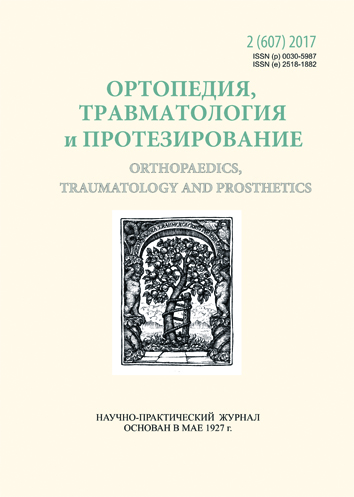Study of stress and strain state distribution of spinal model in surgical techniques for various techniques for thoracolumbar burst fractures (part two)
DOI:
https://doi.org/10.15674/0030-5987201726-13Keywords:
burst fractures, thoracic and lumbar spine, finite element method, stress-strain state, transpedicular fixationAbstract
When choosing the tactics of surgical treatment in burst fractures of the lower thoracic and lumbar spine, the questions remain about the extent of fixation, the possibility of correcting the deformity, and the feasibility of performing a laminectomy.
Objective: to construct finite-element biomechanical models of an burst fracture of the ThXII vertebral body with 100 % lesion in the ThIX–LVvertebra block and analyze the stress-strain state with different types of fixation.
Methods: four models of the ThIX–LVvertebra block were developed: 1) replacement of the fractured vertebral body with an interbody support, destruction of vertebral arches and fixation of vertebrae ThX, ThXI, LI, LIIt ranspedicular c onstruction; 2 ) d estruction o f 100 % of the volume of the vertebral body ThXIIand fixation of the vertebrae ThX, ThXI, LI, LIItranspedicular construction; 3) replacement of the destroyed vertebra by an interbody support, destruction of arches of vertebra ThXIIand fixation of vertebrae ThXI and LI transpedicular construction; 4) replacement of the destroyed vertebra by an interbody support.
Results: it was established that transpedicular construction bears the main load, maximum stresses were found in the posterior parts of the spine (up to 6 MPa) and the sections of the rods between the vertebrae (36.9–65.7 MPa, depending on the model). When using 8 screws without an interbody support for fixation, the stress level increased significantly: in the «screw – bone» region more than 2 times, in the rods — by 70 %. In the case of using 4 screws, the level of stress in the area of the posterior support complex averaged 10–40 % on average.
Conclusions: in vertebral blocks the most strained are the posterior parts of the spine and the portions of the rods between vertebras. The use of a 360° fusion increases the load in the «screw – bone» zone, and only the interbody support — in the region of the posterior parts of the spine.References
- Berezovsky VА. Biophysical descriptions of fabrics of man: The manual. Kyiv: Naukova dumka, 1990. 224 p. (in Russian)
- Knets IV. Deformation and destruction of hard biological fabrics. Riga: Znatie, 1980. 320 p. (in Russian)
- Popsuishapka KO. Metaanalysis of treatment results in lower thoracic and lumbar spine burst fractures. Orthopaedics, Traumatology and Prosthetics. 2016;(4):134–42. doi:10.15674/0030-598720164134-142. (in Ukrainian)
- Obrazov IF. Problems of durability are in biomechanics: Teaching aids for technical and biological specialties of universities. Moskow: Vyshaya shkola, 1988. 311 p. (in Russian)
- Radchenko VO, Popsuishapka KO, Yaresko OV. Investigation of stress-strain state in spinal model for various methods of surgical treatment of thoracolumbar burst fractures (part one). Orthopaedics, Traumatology and Prosthetics. 2017;1:134–42. doi: 10.15674/0030-59872017127-33. (in Ukrainian)
- Langrana NA, Harten RD, Lin DC, Reiter MF, Lee CK. Acute thoracolumbar burst fractures: a new view of loading mechanisms. Spine. 2002;27(5):498–508.
- Liebschner MA, Kopperdahl DL, Rosenberg WS, Keaveny TM. Finite element modeling of the human thoracolumbar spine. Spine. 2003;28(6):559–65. doi: 10.1097/01.BRS.0000049923.27694.47.
- Lazoglu I, Akgun E. Rigid and dynamic spinal system modeling by finite elements methods (in Turkish). Intervertebral disc disease and dynamic stabilization of lumbar spine. Ed. Ozer AF. V. K. V. American Hospital Publications, 2011. Chapter 7. рр. 72–84.
- Altay M, Ozkurt B, Aktekin CN, Ozturk AM, Dogan O, Tabak AY. Treatment of unstable thoracolumbar junction burst fractures with short- or long-segment posterior fixation an magerl type A fractures. Eur Spine J. 2007;16(8):1145– 55. doi: 10.1007/s00586-007-0310-5.
- Sasso RC, Renkens K, Hanson D, Reilly T, McGuire RA Jr, Best NM Unstable thoracolumbar burst fractures: anterior-only versus short-segment posterior fixation. J Spinal Disord Tech. 2006;19(4):242–8. doi: 10.1097/01.bsd.0000211298.59884.24.
Downloads
How to Cite
Issue
Section
License
Copyright (c) 2017 Volodymyr Radchenko, Kostiantin Popsuishapka, Oleksandr Yaresko

This work is licensed under a Creative Commons Attribution 4.0 International License.
The authors retain the right of authorship of their manuscript and pass the journal the right of the first publication of this article, which automatically become available from the date of publication under the terms of Creative Commons Attribution License, which allows others to freely distribute the published manuscript with mandatory linking to authors of the original research and the first publication of this one in this journal.
Authors have the right to enter into a separate supplemental agreement on the additional non-exclusive distribution of manuscript in the form in which it was published by the journal (i.e. to put work in electronic storage of an institution or publish as a part of the book) while maintaining the reference to the first publication of the manuscript in this journal.
The editorial policy of the journal allows authors and encourages manuscript accommodation online (i.e. in storage of an institution or on the personal websites) as before submission of the manuscript to the editorial office, and during its editorial processing because it contributes to productive scientific discussion and positively affects the efficiency and dynamics of the published manuscript citation (see The Effect of Open Access).














